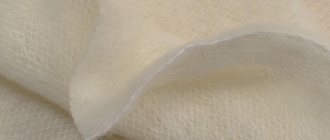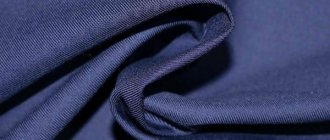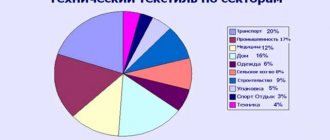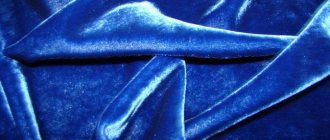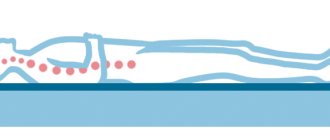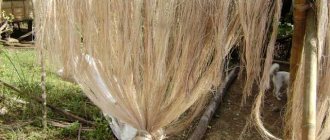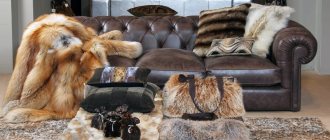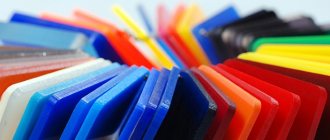What are artificial mineral fibers?
The term IMV is a generic name for a wide range of manufactured fibrous materials. They have a wooly consistency, usually made from molten glass, stone or slag. Individually they may be known as glass wool, stone wool or slag wool according to the materials from which they are made. This term does not include naturally occurring silicate fibers such as asbestos. It also does not include man-made organic fibers such as nylon and rayon.
Read about: identifying fabric for clothing.
There are many different IMVs. Man-made mineral fiber used:
- as thermal and acoustic insulation of buildings and process plants
- for fire protection of buildings
- for pipe insulation
- for highly efficient filtration
- as a replacement for asbestos, the use of which is now prohibited
- IMV is commonly used in insulation boards, heat treatment blankets, electrical insulation, and reinforcement of plastics and cement.
Fiber classification
Taking into account classification characteristics, fibers are divided into:
- natural - chemical.
Natural fibers include fibers of natural (plant, animal, mineral) origin: cotton, flax, wool and silk. Chemical fibers are fibers made in factories. In this case, chemical fibers are divided into artificial and synthetic.
Artificial fibers are obtained from natural high-molecular compounds that are formed during the development and growth of fibers (cellulose, fibroin, keratin). Fabrics made from artificial fibers include: acetate, viscose, staple, modal. These fabrics are highly breathable, remain dry for a very long time and are pleasant to the touch. Today, all these fabrics are actively used by underwear manufacturers, and, thanks to the latest technologies, they can replace natural ones.
Synthetic fibers are obtained by synthesis from natural low-molecular compounds (phenol, ethylene, acetylene, methane, etc.) as a result of polymerization or polycondensation reactions, mainly from products of oil, coal and natural gases.
Commonly used artificial mineral fiber
Some of the commonly used man-made mineral fibers are:
Fiberglass
Fiberglass is produced by a variety of methods that depend on the end product required (such as solid, mat, or rope). For example, it can be made of mineral wool and used for insulation. Mineral wool can also be increased in density and reinforced to create a pre-formed rigid section to be used as pipe insulation.
The resulting glass has an average diameter of about 4-9 µm, which is within the range of inhaled air. Fiberglass may also contain spherical glass particles. These spherical particles typically have a diameter of 100 µm.
Stone wool
Stone wool is produced by melting a mixture of metallurgical and chemical slag with basalt rock, using similar methods used in the production of fiberglass. The resulting stone wool is used as thermal insulation and sound-absorbing material. It is also highly resistant to temperatures up to 600°C and is independent of water. It is used as thermal insulation in industrial installations, pipes and boilers, etc., and for the construction of insulating walls and roofs. Stone wool is also widely used as a sound-absorbing material for television, radio and drama studios.
Ceramic fiber
Ceramic fibers are made from the same group of aluminosilicates that are used in the ceramics industry and are also known as “Aluminosilicate Ceramic Fibers” and “Refractory Fibers”.
Ceramic fibers have been manufactured and used throughout the world since the 1940s. They are produced at temperatures of 2000°C and the manufactured material can withstand temperatures ranging from 1260°C to 1400°C. The material is also resistant to water and most chemicals and is used to make high-temperature fire-resistant gaskets, thermal insulation coatings, felts, ropes, gaskets and papers.
Commodity research and examination of textile goods
1.2 Natural fibers of animal origin
The main substance that makes up natural fibers of animal origin (wool and silk) are animal proteins synthesized in nature - keratin and fibroin.
Figure 5 - Characteristics of natural fibers of animal origin
1) Wool
It is customary to call the hair fibers of various animals: sheep, goats, camels, etc. Wool taken from a sheep is called fleece. Natural sheep wool makes up more than 95% of the total wool. The rest comes from camel and goat hair, goat down, etc.
The main substance of wool fiber is keratin, which belongs to protein compounds. The fiber has three layers: scaly, cortical and core.
Woolen fabrics get dirty a little, wrinkle a little and absorb water, but they strongly absorb water vapor (up to 40% of their own weight) and retain heat well. In order to smooth woolen fabric, just hang the product in a room with humid air.
Woolen products have the property of felting and matting of fibers, so the products are washed with special detergents at a water temperature of 30 degrees, do not rub, do not twist, and do not soak for a long time.
Scaly layer
is the outer layer of fibers and plays a protective role. It consists of individual scales, which are plates that fit tightly to each other and are attached at one end to the fiber rod. Each scale has a protective layer.
Cortical layer
is the main layer of the fiber and includes a number of longitudinally arranged spindle-shaped cells that form the hair body.
In the middle of the fiber there is a core layer
, which consists of loose thin-walled cells filled with air bubbles. The core layer, without increasing strength, only increases the thickness of the fiber, i.e. deterioration of its quality.
Depending on the thickness and structure, the following main types of wool fibers are distinguished: fluff, transitional hair, awn, dead hair (Figure 6).
Figure 6 - Sheep wool fibers
Pooh
- a thin crimped fiber that has two layers: scaly, consisting of ring-shaped scales, and cortical.
Transitional hair is somewhat thicker than down. It consists of three layers: scaly, cortical and discontinuous medullary.
Ost
- a coarse straight fiber that has three layers: scaly, consisting of lamellar scales, cortical and solid core.
Dead hair
- the thickest, coarsest, but fragile fiber. It is covered with large lamellar scales, has a narrow ring of the cortex and a very wide core. Dead hair is a hard, brittle fiber with low strength and poor ability to be dyed [15, pp. 43-52].
Boiled wool.
Modern methods of processing wool can impart unique properties to products. This is what “boiled” wool is like. Highly specialized computer-controlled drum machines felt the wool fibers using precisely defined proportions of water and force at a temperature of 30-40 degrees. The impact of high temperature on wool during the felting process causes it to lose its natural roughness, retain its shape and quality until the end of wear, and does not absorb moisture.
Winter wool has another competitor - “cold” wool.
. These are pure wool worsted fabrics of a special quality made from super soft fine merino wool. They are lightweight, hygroscopic, practical and easy to maintain.
Cashmere
- this is the undercoat of mountain goats of a certain breed, which is not cut, but combed or plucked by hand in the spring, when the animal does not need it after the winter cold. The main suppliers of cashmere are countries with a sharply continental climate - Tibet, Mongolia, China. Cashmere down is combed out with a special pinch. In a year, 1 goat produces approximately 100-200 grams of fluff. For a sweater you will need 4-6 animal down. There are only a few brands in the world that specialize in the production of products from pure Kashmir: Lamberto Losani, Pashmere, Gunex, Rivamonti, Cucinelli.
Mohair fiber
obtained from ancient Angora goat breeds. The main population of Angora goats is bred in Turkey and the US state of Texas. Not long ago, these goats began to be kept in Australia and New Zealand. One Angora goat produces up to 1.6 kg of mohair fiber. Türkiye, the USA and China annually produce up to 25 thousand tons of this fiber. Mohair is a soft and smooth material that is popular among sewers all over the world. Men's and women's clothing and ties are made from it. It is often mixed with lightweight summer wool, making clothes wrinkle less and become silky and shiny.
Llama wool, alpaca, vicuna.
All these animals are representatives of South American camels. Today they live mainly on the high plateaus in the Southern Andes.
Alpacas
sheared from November to April. Alpacas are sheared by hand - in many areas they are still sorted by hand for color and quality.
Vicuna
lives only in some areas of Peru, where it is carefully protected. Vicuna wool is incomparable to any other natural fiber in its softness and strength.
Camel's wool.
Camel wool, capable of withstanding a wide variety of weather influences, has a number of unique properties: low thermal conductivity, high moisture absorption, strength and elasticity. Camel wool is almost 2 times lighter and more delicate than sheep wool, since more than 85% consists of fluff, which is usually combed out once a year. Camel hair, which is combed from the chest of the animal, is considered especially valuable. Washed camel wool, which is not subjected to heat or chemical treatment, is used to produce high-quality blankets and rugs.
Sarly wool
called yak wool. The color of the sarly wool is usually black or brown. It is obtained in the spring, when the yaks molt, and is used to make clothing and blankets.
The production of woolen fabrics consists of several stages, which can be represented in the form of a specific diagram (Figure 7).
Figure 7 - Technology for the production of wool fabrics
2)
The raw material for
silk fabrics
are thread fibers that are secreted by the protein-secreting glands of mulberry and wild silkworms.
Silk fabrics have a noble shine. They are thin, soft, drapey, almost wrinkle-free. Care is required when washing, as silk shrinks and loses its shine. The fabric must not be wrung out or twisted. Wet products are wrapped in cloth and lightly squeezed.
Silk fabrics are characterized by slightly different production stages than wool fabrics (Figure 8).
Figure 8 - Technology for the production of silk fabrics
After primary processing and drying of the cocoons, the thread is wound and raw silk is obtained.
The average length of the wound thread is 1000-1300 m [12, pp. 7-12].
Types of artificial mineral fibers
- Fiberglass
- Reinforced plastics and cements
- Glass insulation
- Mineral wool
- Thermal insulation made of mineral wool
- Ceramic fibers
- High temperature insulation
- Power plants
- Trinity furnace
- Refrigerated gas turbines
- Fireproof fibers, Silicon nitride/carbide
- Limited Special Use
- Specially designed ultra-fine fibers
- Production of special papers
© 2021 textiletrend.ru
How to properly care
Like everything natural, fabrics require special careful care, otherwise they can simply deteriorate, losing not only their shape, color, and becoming covered with unpleasant stains.
- Linen should not be overdried; it is better to iron it slightly damp or purchase a steamer. It is recommended to store linen fabrics without folds in airtight packaging.
- It is better not to wash wool, but to clean it. Knitted woolen items (knitwear) can be washed, but only with special products at low temperatures. Automatic spinning and twisting is prohibited; dry without sagging.
- Silk should be protected from the sun, washed at a temperature not exceeding 30 °C and only with soft detergents, and ironed on a special cycle. It is advisable to remove stains by dry cleaning.
- Cotton is the most unpretentious, but it also requires careful attention. Dyed items made of cotton fabric should be washed only with products intended for colored laundry, and should be protected from fading and caking on folds. When exposed to certain substances (for example, sweat), cotton may locally turn yellow or gray.
How to check the naturalness of fabric at home
Very often, under the guise of natural ones, they try to sell at best a mixture, or even pure polyester, so the ability to check naturalness will never be superfluous.
Truth is learned in fire, so you need to take a small thin piece of fabric, or a few threads from it, and set it on fire.
- Silk and wool smell like burnt hair when burned, but with different intensities.
- Cotton burns at an average speed, does not crack if you sniff it, smells like paper, and leaves virtually no ash.
- Flax burns reluctantly, goes out, and has no smell.
The more synthetics in the fabric, the more merrily it burns, forming a hard fused ball at the end. Ashes after burning natural fibers crumble easily.
Wool
It is most likely the oldest natural material. Woolen fabrics are produced by processing the sheared wool of animals: goats, sheep, rabbits. The main property of the fabric is to retain heat to the highest degree, so warm clothes and hats are made from wool, as well as household items - blankets, rugs, etc.
Fabrics and wool have the following important properties:
- elasticity - easily stretched and take its original shape;
- functionality and practicality - the fabrics are very easy to work with during cutting and sewing;
- safety and hypoallergenic;
- hygroscopicity and breathability manifest themselves differently in each type of wool fabric;
- resistance to stains, rapid dissipation of unpleasant odors.
The main disadvantage of things made from natural wool is their high cost, and also the fact that such clothes are “afraid” of moths.
What wool fabrics are popular when sewing clothes:
- cashmere - for coats, sweaters, jackets and scarves;
- gabardine - outerwear, as well as backpacks, suitcases;
- wool flannel is mainly used for sewing demi-season coats and blankets.
- tweed - for business suits;
- felt – hats, shoes, decor.
Classification and properties of natural fabrics
Natural materials – produced from the gifts of nature without any special chemical treatment. Regardless of the type, they all have the following characteristics:
- allow air to pass through, allowing the skin to breathe, and some retain heat;
- high strength of the material, which is difficult to tear manually (especially silk and linen);
- practically weightless - according to this indicator, sometimes clothes made from natural fibers outperform synthetic ones;
- elasticity of the fabric, resistance to stretching and compression;
- hygroscopicity;
- have a limited service life.
Its further properties depend on which group the natural fabric belongs to.
Types of fabrics are classified according to their sources:
- animal origin (obtained as a result of animal shearing);
- from fibers of plant origin - obtained by processing grown crops;
- mineral materials obtained by processing rocks.
Let's talk about each material and its properties in more detail.
Linen
Linen fabric has been known to mankind since ancient times - even on the mummies of the pharaohs of Egypt, remains of this material were discovered, and the ancient Slavs also made clothes from linen. The exclusivity of flax is that it can be used to make both the finest almost transparent cambric and coarse tarpaulin.
According to their purpose, linen fabrics are divided into the following groups:
- for sewing sundresses, shirts, trousers, suits and other clothes;
- for bed linen;
- for the production of tableware - tablecloths, sheets, towels;
- for technical products - bags, ropes, tarpaulins.
Fabric properties for which linen is so valued:
- breathability and thermal comfort - even in extreme heat it is not hot in linen clothes, and body temperature in such fabric can even drop by a couple of degrees;
- moisture absorption and evaporation;
- strength and super strength, abrasion resistance;
- wear resistance without loss of original appearance;
- safety and hypoallergenic;
- The material is easy to clean and wash, and does not electrify at all.
However, the big disadvantage of linen fabrics is their high wrinkleability during use, and a lot of time is spent on smoothing out creases formed during wear.
Advantages and disadvantages
clothing made from natural fabrics
natural fabrics for curtains
things made from natural fabrics
organic fabrics
The main advantage of natural fabrics is the awareness of the naturalness of their origin, the proximity to nature through their use. However, industrially produced natural fabrics can no longer be called organic, since acids, alkalis, and other chemicals are used in their production. When growing cotton, volumes of carbon dioxide are released into the atmosphere comparable to those produced by livestock farming.
The hypoallergenic nature of natural fabrics is a myth; many people are allergic to wool or linen.
Despite the fact that many consider natural fabrics ideal, they have many disadvantages:
- linen is not plastic, does not stretch, wrinkles heavily, is difficult to iron, loses its shape, is harsh compared to other natural fabrics, absorbs odors during storage;
- cotton wrinkles, wears out quickly, fades, loses color;
- silk is often counterfeited due to its high price;
- the wool shrinks, dries poorly, attracts various insect pests;
- Dust from asbestos fabric accumulates in the lungs and can lead to cancer.
It was possible to get rid of a significant number of disadvantages in mixed fabrics; for example, cotton with wool does not have the disadvantages of both.
